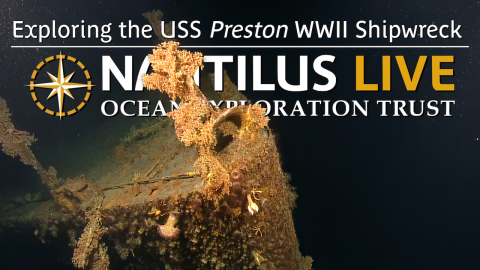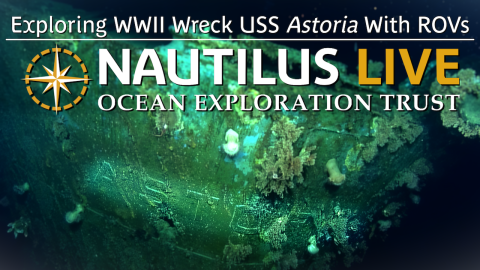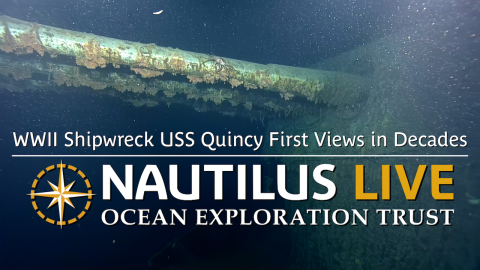My Nautilus Experience
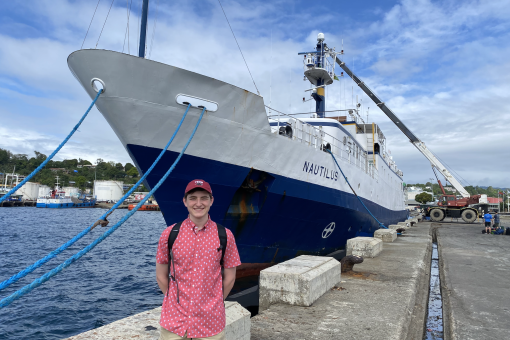
This blog was written by NA173 Ocean Science Intern Bill Fallon.
I was sitting in my seminar class, a sort of study hall, when I received the email confirming I would be on the EV Nautilus. It was such an amazing and welcome surprise to learn I would be on board the Nautilus for the Maritime Archaeology of Guadalcanal: Iron Bottom Sound NA173 expedition. The first thing I did after reading my acceptance email was step outside to call my Grandpa; he was the first to tell me about the Nautilus, and I knew that he deserved to be the first to know. When I applied, I never thought in a million years I would actually get accepted. I mean, there must be hundreds of more accomplished applicants, but I got chosen after all!
The expedition I am on aims to explore and discover wrecks from the major naval battles of Guadalcanal in World War II. We use sonar on the ship and the uncrewed surface vessel DriX to locate targets, and then dive on them with the ROVs Hercules and Atalanta. It’s great that this is the expedition I was chosen to be on, because I am a huge history buff and I especially love naval history and warships. One of my walls is even covered in posters of different ships!
Even as I packed my bags and got supplies the week before I left, I couldn’t believe it. No way I am actually about to be thousands of miles from home working on one of the most famous research vessels in the world. After months of eagerly waiting, I finally arrived at the Nautilus, having endured two flights, twelve-plus hours in the airport, three trips to Burger King, and a night in a hotel. It was super exciting pulling up next to the ship and seeing her for the first time. After all the time spent waiting, interviewing, and preparing, I was finally here, and it felt surreal. And after taking a COVID test, I finally stepped on board!
My first thought after getting inside was “Whoa, this is nice.” The main deck is covered in polished wood and furnished very nicely; it’s very comfortable. My stateroom is a three-person room, but is only occupied by me and my roommate, Jacob. I’ve got the top bunk and he has the bottom. The third bed has served as a spot to place some clothes and belongings. The beds have curtains for privacy and are extremely comfortable. When the door is shut and the lights are off, it’s pitch black, making it easy to fall asleep.
As an Ocean Science Intern on board the Nautilus, my job is to serve as a Data Logger. During our dives, whenever I am on watch from 4-8 AM and PM, I record everything that happens during our ROV dive, including dive status updates and any issues we encounter. I also remotely take photos from Hercules or Atalanta when we come across something interesting. When I’m not on watch, I am either catching up on sleep, working out, or chilling in my room/on deck. Off time isn’t all free time; however, as there is still work to be done.
I am fairly knowledgeable about naval history and ships, so I was also tasked with gathering 3D models of the ships sunk in Iron Bottom Sound. We then used these models to help orient ourselves while on wrecks and identify pieces of wreckage. I also wrote my first blog post (this being my second) which reviewed the three main ship types of wrecks off Guadalcanal. Originally, I was supposed to spend only a week on board, but due to openings in the bunking plan, I’ve been here for the entire month- the length of the whole expedition.
While the members of my 4-8 watch often find themselves viewing long hours of blue screens during our towing sessions as we transit between different sites, we were also the watch that located the two previously unknown wrecks. The first unidentified wreck we dove on was the bow of USS New Orleans. Located by our sonar and only identifiable as a small blip, we were unsure of what it was until we conducted a visual survey. The bow had been torpedoed off during battle, sinking to the seafloor while the rest of New Orleans sailed back using a bow made from coconut logs.
The second new wreck we found was IJN Teruzuki, a Japanese destroyer. This was certainly the coolest find for me, a mostly intact destroyer that hadn’t been seen for over 80 years! Working to identify it was very enjoyable; we first identified it as an Akizuki class after surveying the wreck and its turrets. From there, we used a process of elimination to ID it as Terezuki. Teruzuki was the only other Akizuki class sunk in the sound, and the other Akizuki class wreck was already located, so it could only be Teruzuki!
One of the best parts of being on board Nautilus for me is all of the other people I sailed with! There are so many people with different backgrounds, professions, and personalities. No matter who you talk to, there is something to be learned. Frank Thompson is one of our historians, and as director of the Artifacts Department of the US Naval History and Heritage Command, he knows almost everything there is to know about the various US ships and the Battle of Guadalcanal. Hiroshi Ishii is another historian, and we’ve discussed the Japanese ships as well as what we miss about Japan, where we both have lived in the same prefecture.
Having all these people knowledgeable in such a wide range of fields is truly amazing; there is always something to learn or an interesting story to be told. There is just a wonderful atmosphere onboard because everyone is happy to be here, and we are all passionate about the ocean and what we are doing with OET and Nautilus. Being on board also makes me realize what a small world we live in. Hiroshi and I both lived in Kanagawa. My roommate Jacob used to live in Yokosuka (where I live now) as a sailor, and my fellow intern, Tea, lives only two hours from my college!
I am finishing this blog just a few days before I depart and head home. My time onboard the Nautilus has been amazing, and I know I will remember this expedition for the rest of my life. Having the opportunity to visit a site of such historical importance is truly a privilege. While it is certainly exciting and fun to survey the wrecks and share our findings live, there is a sadness to it. I think about how more than 30,000 sailors lost their lives where we are; to me, that number is incomprehensible. The scale of suffering and death that occurred here is truly hard to grasp. It is very sobering for me to think that on these wrecks I am observing, there are the remains of hundreds of young men barely older than me.
I am honored to have the privilege of helping to educate the public on these battles, and I hope it helps the world to remember the ultimate sacrifice these men made. I am so thankful for the opportunity to be on the Nautilus, and I can’t wait until my next expedition! And for any college students or early career professionals out there reading this, apply for the internships! Don’t sell yourself short because Nautilus welcomes people with all levels of experience, from scientists with PhDs to brand-new college students like myself!
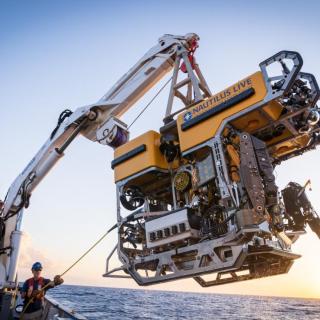
Maritime Archaeology of Guadalcanal: Iron Bottom Sound
Located in the Solomon Islands between the islands of Guadalcanal, Savo, and Nggela, Iron Bottom Sound was the stage of five major naval battles between August and December 1942 which resulted in the loss of over 20,000 lives, 111 naval vessels, and 1,450 planes. These underwater cultural heritage sites now rest on the seafloor offshore Honiara in a confined area less than 25 nautical miles wide, 40 nautical miles long, and 1,400 meters deep.
